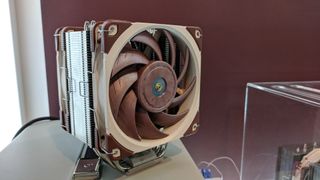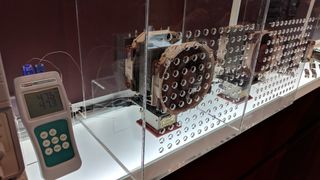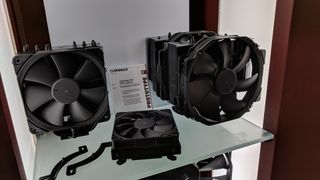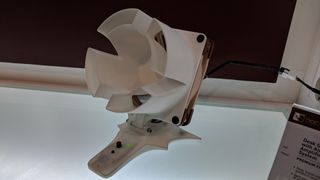Noctua was the only hardware company at Computex totally ignoring RGB
And I love them for it. Sweet relief for weary eyes.

There's an eerie feeling that settles in when you approach the booth of cooling company Noctua on the Computex show floor. It's a little like stepping back in time 10 years. Everywhere else in the convention center, where there are PC cases, fans, graphics cards, mice or keyboards or headsets, there are dancing RGB lights. But not here. Here, it's… calm? Quiet. Dignified. Unlike the rest of the hardware industry, Noctua doesn't give a single damn about colorful lights.
All Noctua really cares about is cooling, which has paid off with its latest fan design, the NF-A12. I wrote about it at Computex last year, and even though Noctua had spent more than four years iterating on the fan's new 120mm design and the new polymer used in its blades, it took another year (until just this past month) for the fan to finally see release.
Noctua's engineers are hard at work on a 140mm version, but that's still at least a year out; according to Noctua's Jakob Dellinger, the 120mm version performs so well they're having trouble beating it with the 140mm design. In the meantime, you can get a mounting bracket for the 120mm fan to add it to a 140mm radiator or cooler, where Noctua is confident it will outperform most 140mm fans.
Case in point: probably the most exciting upcoming product at Noctua's booth this year is a new CPU cooler, the NH-U12. This cooler uses a pretty standard single tower radiator, with a few upgrades over Noctua's previous design, the U12S. There are now seven heatpipes and more fin surface area for heat dissipation (about a 38 percent boost). Tellingly, though, Noctua wasn't comparing the new NH-U12 cooler (which naturally uses that new top-of-the-line NF-A12 fan) to the previous model. It was set up against a dual tower 140mm cooler that dwarfed it in size.
Running side-by-side with dual fan configurations, the new cooler delivered performance within a degree of its much larger predecessor.

Both fans were keeping a demo setup running at around 47C. If that sounds a bit on the warm side for a high-end cooler, well, it's because the demo was replicating a CPU running at 220 watts. The TDP of the Intel i7-8700K is 95 watts. So yeah, that new cooler's going to do very well under real conditions. And the bigger advantage Noctua topped off was space inside your case: unlike the 140mm cooler, the new model won't bump up against any RAM. It should fit in any typical ATX build, no problemo.
It was refreshing to visit a single booth at Computex dedicated to pure performance, and Dellinger was matter-of-fact about the lack of blinking lights in the booth. Time spent adding RGBs to fans is engineering time that could be spent making those fans perform better, instead. Noctua has no plans to go RGB. The company has made a concession to looks, though, by adding more all-black components to its Chromax line, so it'll be easier to get svelte black CPU coolers and fans that deliver Noctua-caliber performance while blending into a case.
The biggest gaming news, reviews and hardware deals
Keep up to date with the most important stories and the best deals, as picked by the PC Gamer team.

There was one last delightful treat in the booth: a desk fan Noctua is making, by mounting an "airflow amplification system," aka a really fancy funnel, onto one of those new NF-A12 fans. This model was just a prototype, so the final version will be much prettier. Despite its small size, I could feel air from this thing with my hand more than two feet away. I don't know if I'd pay Noctua prices for a desk fan, since the NF-A12 by itself costs $30, but I enjoy the fact that it exists.
I never knew "what do fan nerds do in their spare time?" was a question I'd want asked and answered, but here we are: they build other kinds of fans.

As with most of Noctua's products, development is slow and steady, so it'll be a good while before we see the desk fan on sale. The new CPU cooler, the NH-U12, will cost around $100, and should be out by the end of the year.

Wes has been covering games and hardware for more than 10 years, first at tech sites like The Wirecutter and Tested before joining the PC Gamer team in 2014. Wes plays a little bit of everything, but he'll always jump at the chance to cover emulation and Japanese games.
When he's not obsessively optimizing and re-optimizing a tangle of conveyor belts in Satisfactory (it's really becoming a problem), he's probably playing a 20-year-old Final Fantasy or some opaque ASCII roguelike. With a focus on writing and editing features, he seeks out personal stories and in-depth histories from the corners of PC gaming and its niche communities. 50% pizza by volume (deep dish, to be specific).
Most Popular


